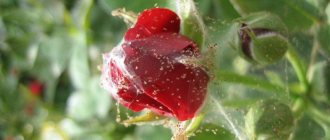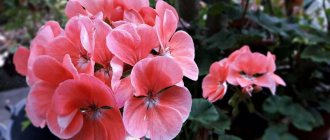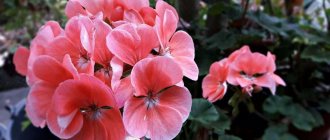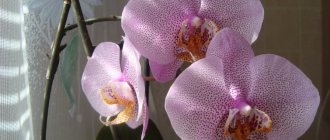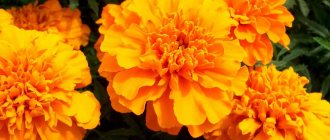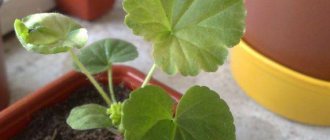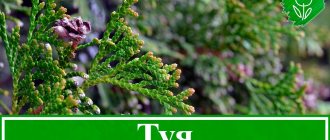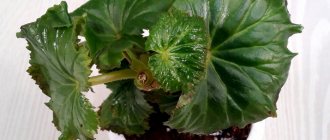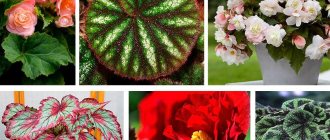White coating on begonia leaves: reasons for its appearance
When a bush is infected with the fungus Oidium begoniae, a white powdery coating forms on the above-ground part of the begonia. First, spots appear, gradually the tissue turns glassy and the leaf dies.
Powdery mildew appears due to leaves being wet for a long time and high air temperatures. Also, the disease can be provoked by the application of nitrogen fertilizers in large quantities with a simultaneous lack of calcium in the soil. Powdery mildew actively develops on begonia bushes with low turgor, since such a plant does not resist fungus well. If growing conditions are favorable for begonia, pockets of powdery mildew are localized and do not cause serious harm to the bush. Most often, the disease manifests itself when the temperature drops to 18-20°C and the humidity rises to 60-80%.
How to cure begonia from white plaque?
It is clear that it is necessary to create favorable conditions for begonia: ventilate, regularly water, provide sufficient light and temperature. Dried and diseased leaves are carefully removed from an infected begonia. If there are few foci, diseased shoots are cut off.
How to treat begonia? You can apply this treatment, maintaining a gap of a week: first, spray with a solution of potassium permanganate (2-3 g of granules, 10 liters of water), then the leaves are washed with a soapy solution of soda ash (10 liters of water, a little less than half a bar of soap, 50 g of soda). A week later, the begonia is sprayed with garlic infusion, for which 15 g of crushed cloves are taken per liter of water (the product needs to infuse for a day).
You can spray the affected begonia with a mixture of antibiotics (diluted 1:1) - penicillin tablets 100 units/ml, terramycin (same dosage). As for fungicides, Skor, Topaz, Benomyl, Anvil, Baykor, Rubigan, Vectra and other preparations of similar action are used to treat begonias against powdery mildew.
Experienced gardeners use fermented slurry to suppress the growth of powdery mildew fungus. To prepare the solution, dissolve 1 part manure in 3 parts water and leave the liquid for 3 days. Before use, you need to dilute the product in a ratio of 1:3.
Begonia diseases can quickly turn a gorgeous flower into an unsightly, tortured specimen. Therefore, for flower growers who purchase an ornamental plant called begonia, diseases and the fight against them become one of the main problems.
Powdery mildew on indoor plants: prevention and treatment
Powdery mildew can occur on many types of plants, both outdoors and indoors. In indoor conditions, powdery mildew can be found on roses, gerberas, cineraria, Kalanchoe, begonias, cissus, and violets. The cause of the disease is stagnant, humid air and sharp fluctuations in room temperature.
Powdery mildew spreads when a diseased plant comes into contact with a healthy one, during watering, and is carried by insects or air flow. Treatment of powdery mildew should begin as early as possible.
Causes of powdery mildew on indoor plants
First of all, this is due to stagnant, humid air in the room and sharp temperature fluctuations. The spread of the disease also occurs through contact between sick and healthy plants, during watering, with air flow, and also when carried by insects.
Latest articles about gardening
The cause of the development of the disease can be excessive use of nitrogen fertilizers, as well as a lack of calcium in combination with high temperature and humidity in the room. At the same time, abundant watering is not at all a reason for the development of powdery mildew.
Signs of damage to indoor plants by powdery mildew
Powdery mildew (powdery mildew) is caused by powdery mildew fungi. There are many species of these fungi that parasitize a wide variety of plants, including indoor plants (for example, Oidium species). The first sign of powdery mildew appearing on your plant is a characteristic white coating on the leaves (mycelium) in the form of small shapeless spots, which is easily cleaned off.
Gradually, the whiteness takes over the stems and other parts of the indoor plant. Over time, the spots increase in size, the mycelium thickens (becomes felt), the plaque darkens and acquires a brownish color.
It should be noted that flowers can also be affected by downy mildew (downy mildew), the external signs of which are similar to real linen. But, unlike real mildew, downy mildew in the form of a coating appears only on the underside of the leaf blade, then the spots turn yellow, increase in size and then acquire a brownish color.
Folk remedies for combating powdery mildew on indoor plants
There are many folk remedies for powdery mildew that are safe for humans and plants. For example:
- soap-soda solution: dissolve 50 g of soda ash or baking soda and 20 g of liquid or grated soap in 10 liters of water and treat the plants at least twice at intervals of a week;
- whey solution: pour 1 liter of whey into 10 liters of water, stir and apply three times in dry weather with an interval of 3 days;
- kefir solution: stir 1 liter of fermented kefir or yogurt in 10 liters of water and treat the plants three times with an interval of three days;
- horsetail decoction: pour 100 g of horsetail with one liter of water, leave for 24 hours, simmer for two hours over low heat, cool, strain, dilute with water 1:5 and carry out 3-4 treatments at intervals of five days. Undiluted, the decoction is stored in a cool, dark place for about a week;
- mustard solution: dilute 2 tablespoons of mustard powder in 10 liters of warm water and spray or water the plants;
- potassium permanganate solution: dissolve 5 g of potassium permanganate in 10 liters of water. This solution stops the development of the disease and washes away the fungus from the fruit;
- ash solution: add 1 kg of wood ash to 10 liters of water, stir, leave for 7 days, carefully drain, dissolve 20 g of liquid or grated soap in the infusion and treat the plants with this composition every other day;
- garlic infusion: 50 g of garlic pulp (crushed cloves and shoots of garlic) are poured with two liters of water, infused for two days and filtered. Use the infusion undiluted;
- infusion of onion peels: 200 g of onion peels are poured into 10 liters of boiling water, infused for two days, filtered and sprayed on the plants before flowering, after it and before leaf fall.
Special chemical preparations for powdery mildew on indoor plants
If powdery mildew appears on your flowers, combating it is most effective with the help of modern fungicidal agents. They have a detrimental effect on the fungus, stop harmful processes in plant cells, protect and treat it. Spraying is carried out 1-4 times with an interval of 7-10 days (depending on the chosen drug).
Articles for flower growers
The most effective drugs for powdery mildew:
A well-known fungicidal drug is phytosporin, the active ingredient of which is a concentrate of the bacteria Bacillus subtilis in a powder of chalk and humates. Despite the fact that phytosporin is considered a medicinal agent, it is practically useless against existing powdery mildew. However, as a preventive measure, it will work flawlessly.
Prevention of powdery mildew on indoor plants
Like most other plant diseases, powdery mildew is easier to prevent than to cure. Therefore, prevention is the first remedy against such a fungus. And any prevention is, first of all, correct agricultural technology. To minimize the risk of infection you should:
- regularly thin out plantings; - remove old leaves in contact with the ground; - water the plants only after the top layer of soil is completely dry; — do not abuse nitrogen fertilizers;
— carry out phosphorus-potassium fertilizing on time.
Another type of prevention against powdery mildew can be carried out in early spring, before the leaves bloom. Berry bushes and other perennials are simply scalded with boiling water. This must be done quickly, using a watering can with a diffuser. You should pour over all the branches as a whole, without lingering long in one place.
A short-term exposure to very hot water does not have time to harm plants that have not yet fully awakened after winter. But spores, mycelium, as well as pathogens of other diseases, die. A jet of steam under pressure produced using a household steam cleaner has a similar effect.
When improper care is to blame
Begonia cannot be called unpretentious. The plant needs good care. Otherwise, illnesses begin to overcome him.
Leaves curl and dry
In this state, the plant signals a severe lack of moisture in the soil and air. To save it, it is necessary to urgently water it and remove it from the bright sun, and to prevent such situations in the future. Begonia is light-loving, but direct sunlight is not an easy test for it.
New leaves grow small
This is how begonia reacts to a decrease in soil nutrition. The plant needs to be fed. Liquid fertilizer for domestic flowering plants is optimal for quick help. And in the future you should not neglect feeding, do it every 2 weeks. Leafy begonias need fertilizers rich in nitrogen, while flowering begonias need fertilizers rich in phosphorus.
Important! The best soil for planting begonias is considered to be a mixture of leaf soil (1 tsp), humus, peat and sand (0.5 tsp each).
Stems and tops are affected by rot
This is a continuation of root rot, which appears when there is excess moisture. To eliminate it, it is necessary to stop watering for a while, place the begonia in the sun, and in the future avoid waterlogging.
Important! The flower does not like changes in location, so this is done only in vital cases.
In winter the leaves fall
Discoloration and winter fall of leaves eloquently indicate too cool a temperature or the presence of drafts, which begonia really does not like. Eliminating these reasons will return everything to its place.
Blooming begonia: diseases and their control
The group of flowering begonias is even more demanding on growing conditions, because the formation of buds, flowering, and seed formation lead to an increased consumption of vital energy. The slightest failure can cause illness.
Leaves are limp and dry
This is a consequence of a lack of water at the roots and in the air. A flowering plant needs full watering. The art of the gardener is not to overwater the begonia, but also not to starve it.
Important! For begonias, which originate from the tropics, high air humidity is vital. However, the result of spraying is brown spots. It is best to turn on a humidifier or place flower pots on a tray with expanded clay or moss moistened with water.
Yellowed leaves
Drooping, yellowed leaves clearly indicate that the plant is watered too often, but does not provide the necessary warmth. As a result, problems with flowering appear. All these shortcomings require immediate elimination.
Rot has settled at the base of the stems
This is also an indicator of excessive water use. Control measures: the soil must be dried urgently and the correct conclusions must be made regarding watering. Otherwise, the plant will die.
Leaves, flowers, buds rot
When the bases of the stems are not damaged, but the leaves of the begonia, its flowers, and buds are affected by rot, this
Flowering begonias are affected by pernosporosis (downy mildew)
the result of frequent spraying of a plant for which such a procedure is absolutely contraindicated. Begonia is defenseless against excess moisture.
Downy mildew
Along with ordinary powdery mildew, flowering begonias are affected by pernosporosis - downy mildew. The spores of these fungi are contained in the soil and are activated when soil and air humidity increases. The disease appears as white spots that are soft to the touch, spreads instantly and leads to the death of leaves. Control measures are similar to treatment for powdery mildew.
Main pests of begonias
Despite their small size, begonia pests are aggressive, insatiable and can lead to the death of the plant. Fighting them is not an easy task and requires patience and perseverance.
Greenhouse whitefly
A tiny (1.5 mm) butterfly, having settled on the leaves of a begonia, multiplies incredibly quickly and actively sucks the juices from the plant. In an apartment, a harmful insect is eliminated with a solution of 10 liters of water and 40 g of soap. Leaves on which larvae have settled on the reverse side will have to be destroyed. In greenhouses and open ground, potent intexicides are used: Apploud, Aktaru, Teppeki, Mospilan - three times, at weekly intervals.
Nematodes – leaf and root-knot
Leaf nematodes target the stems, leaves and buds of begonias, gall nematodes settle on the roots and lower part of the stem, but the final result of the activity of microscopic worms is the same - the death of the plant. Pests detect their presence by light green spots that turn brown over time and specific swellings.
Preventing the appearance of nematodes is much easier than getting rid of them later. Therefore, the planting soil must be steamed. If a pest is detected, the affected areas are removed, and the plant is watered with Heterophos at a concentration of 0.05-0.2 percent.
Soft false scale
Another parasitic insect is the soft scale insect. These begonia pests actually hide inside the plant, which stops growing and eventually dries out. The only method of control is painstaking manual cleaning with a soft brush moistened with garlic infusion of the areas of the plant that have been infested by pests. The operation is repeated continuously after 2-3 weeks.
Spider mites on begonia leaves photo
Red spider mite
If a thin web begins to entangle the begonia, it means that the plant has been chosen by spider mites - lovers of warmth and abundant humidity. Over time, the color of the leaves will become marbled, and then they will turn yellow and fall off. Pests will retreat after spraying the diseased plant with Decis.
Greenhouse aphid
Pests reproduce like an avalanche: 1 female produces up to 100 new insects every 7 days. And they are all busy sucking the juice from the withering plant. At home, you can get rid of aphids by spraying with tobacco infusion (100 g of shag is infused for 2 days in a liter of water, diluted 2 more times before use) and a solution of soap.
Greenhouse thrips
Due to their rather large size, pests are clearly visible. The harm they cause is also visible to the naked eye: the leaves lose color, the plant stops growing, and loses its beauty. Thrips love humidity and high temperatures, so they most often attack begonia in the summer.
Problems with decorative deciduous begonias due to improper growing conditions and care for them
Begonia leaves curl and dry at the edges
A similar reaction can develop in a plant due to excessively dry conditions, when it does not receive enough moisture from either the air or the soil. In order for the leaves to recover as quickly as possible, the begonia needs to be watered and removed from a windowsill with too much light.
New begonia leaves are small
Begonia is a plant that is very demanding on soil nutrition. Therefore, even if you repot it regularly and use fresh soil mixture, as winter approaches the plant may notice the appearance of very small new leaves.
In this case, it is recommended to feed the begonia a little. A liquid fertilizer intended for flowering indoor plants is ideal for this purpose. It would be useful to give the plant a complex composition of such fertilizing every two weeks.
The plant drooped, the begonia leaves bowed
If the begonia has drooped, its leaves have become limp and unattractive, then, most likely, this was caused by keeping the begonia in the kitchen, where a gas stove is regularly used.
Unfortunately, this plant is very sensitive to gas combustion products. Therefore, the only thing that can be done in such a situation is to move the flower pot to another, well-ventilated room.
Stem and blossom end rot at the base of begonias
Most often, fans of this plant are faced with the fact that the roots of the begonia rot, but often the stem part also begins to rot. The reason is excessive moisture of the plant, as a result of which a lot of water accumulates in its stems and leaves.
Begonia can recover only if it is placed in a well-lit place by the sun, and watering is also significantly reduced so that the soil can dry out a little.
Begonia leaves fall off in winter
If in winter the begonia leaves become discolored and begin to fall off, it means that the room is too cool, or the window on which the plant stands is most likely being blown by a cold wind.
To prevent the plant from losing all its leaves, move it to more comfortable conditions or at least seal the windows against drafts.
Rules of care
Failure to comply with plant maintenance conditions has a detrimental effect on its development and appearance. The following signs and causes of deterioration in the condition of begonia associated with improper care are identified:
- The formation of brown spots and gray plaque on the leaves - the cause of the disease is insufficient ventilation of the room, excessive watering. It is possible that the flower is located away from the light source.
- Yellowness of the leaves - the plant does not have enough sun, a violation of the soil moisture regime.
- Shedding of leaves means little sun.
- The leaves dry out and curl - the room is too hot.
- The green cover withers and rots - excessive watering, the pot does not have a drainage layer and holes for removing excess moisture.
- The tips turn brown - the air in the room is dry.
- The leaves turn white, signs of rotting appear - excess moisture in the pot.
- When flowering, buds and leaves fall off - the plant is in a draft, excessive moisture, a sharp change in air temperature.
If all the rules for maintaining the plant are followed, you should dig deeper - perhaps a pest has settled on the begonia or it has become infected with some disease. Let's look at this issue in more detail.
Diseases of decorative deciduous begonias
Begonia diseases can spread both from other plants and from poor soil collected in the garden, or from an undisinfected pot, or even pruning tools. Incorrect care often leads to this.
Yellow rings and spots on begonia leaves
Unfortunately, if such a symptom appears, it is better to destroy the plant. The fact is that yellow rings and spots, which subsequently lead to leaf deformation, are left on the plant by
the cucumber mosaic virus .
There are no means to combat it, but it spreads quite quickly and actively, so if you have it, try to immediately destroy the source of its spread.
Gray mold
Gray rot or mold on the stems and leaves of a plant appears as a greenish powdery coating with a slight tint of brown. It often affects not only the leaves, but also the flowers of begonias, which is why mold must be dealt with urgently.
To get rid of mold, the plant
is treated with Benomyl . In addition, since mold most often forms due to excessive humidity, it is better to move the plant to a dry and cool room during the “treatment” period.
Powdery mildew
If a plant is affected by this disease, white spots with powdery powder will rapidly form on its leaves and stems. To stop the development of the disease, be sure to treat the plant with fungicides .
It would also be a good idea to move the flower to a well-ventilated, cool room, since in such conditions powdery mildew practically does not appear and does not spread.
Black root rot
If you notice that your favorite begonia has significantly stunted its growth and is beginning to wilt, you can try replanting it. If during the replanting process you see blackened roots that have begun to rot, the plant is suffering from black root rot.
The same spraying with Benomyl . To prevent the development of such a disease from reoccurring, control watering and under no circumstances over-moisten the soil in the pot.
Diseases
Not many diseases affect begonia, but it is important to carry out timely treatment to prevent the death of the flower. We present to your attention the diseases of this plant, their signs and methods of rehabilitation.
Powdery mildew
First of all, let's consider what to do if powdery mildew appears on begonia. This disease is more common than others and affects all components of the plant that are located above the soil surface. The first sign of appearance is round spots with a white coating on the leaves. Over time, they grow, covering the entire plate. If no action is taken, the foliage will turn brown and fall off.
Treatment consists of the following medications:
- solution of morestan (0.05%) or foundationol (0.05-0.1%);
- colloidal sulfur solution (0.3-0.5%) – spraying is carried out during the growing season;
- 2 grams of copper sulfate and 20 g of tar soap are dissolved in a liter of water - a fairly effective remedy that can be prepared from scrap materials available to any gardener.
Gray rot
When studying tuberous begonia diseases and their treatment, one should not exclude the possibility of the formation of gray rot, whose appearance is associated with a microscopic fungus called botratis. Its development is promoted by a large amount of moisture and warm air in the room. As a result, spores form and move to other plants in the room when watered or due to the wind.
Signs include the appearance of watery, gray spots on leaves and buds. Usually the damage starts from the top of the plant. Subsequently, the spots become similar to wet rot, the flower stalks become covered with mucus, and the stems rot and die. The foliage turns black and falls off completely.
Treatment consists of spraying the begonia with a soap solution (in the ratio indicated in the list above) or Bordeaux mixture (1%).
Note! If the plant is grown in a greenhouse, then sufficient ventilation should be provided and watering should be reduced to the required minimum.
If the flower is severely damaged, spray with a special solution, which consists of the following components:
- Topsin – 0.05-0.2%.
- Polycarbacin - 0.4%.
- BMK - 0.05-0.1%.
- Fundazol in the same concentration.
- Euparen – 0.2%.
Bacterial spot
The first stage of the disease appears as small watery spots on the back of the plate. When brown spots are noticed on the leaves of a begonia, we can talk about the second stage and a severe disease of the plant. At the same time, blackening of the buds and petioles occurs. There is no effective treatment, so the flower is destroyed. The soil must be disinfected before reuse, but it is better not to risk it and throw it away.
As a preventive measure, treatment is carried out with a suspension of copper oxychloride (0.5%). The procedure is repeated after 2 weeks.
Banal dry air should not be ruled out. In this case, brown spots form only at the tips of the leaf blade. A solution might be to place a container of water nearby or install an automatic humidifier.
Ring spot
This disease is caused by a tomato virus. Appears as yellow-green concentric lines or spots. The plant may acquire a bronze color, and some areas become necrotic. Often the carrier is one of the types of sap-sucking pests. Insects should be removed immediately to prevent infection of other flowers.
There are no effective methods for rehabilitating begonia, so the plant will have to be thrown away. Even when treated with fungicides, the virus will remain in the root system and make itself felt next spring.
Black root rot
Due to this begonia disease, the leaves wither at the edges for no apparent reason. You can detect signs when replanting the plant - black spots of rot will be visible on the roots. The damaged areas are removed, after which they are treated with Benomyl.
Prevention lies in proper watering - the soil should not be flooded, moisture is replenished only after the top layer of soil dries out.
Vascular bacteriosis
Signs: the edges of the leaf turn yellow, then become darker, acquire a brown color, and oily spots appear. The vessels through which the juice moves turn black. Treatment consists of removing the affected leaves and treating with fungicides.
Problems with flowering begonia due to improper growing conditions and care for them
During the flowering period, begonia requires the most attention, since for active vegetation the plant needs a sufficient amount of nutrients, moisture and sunlight. But since begonia is very picky in this matter, not everyone can guess its wishes.
Begonia does not bloom, new leaves are small
Lack of flowering and poor development is evidence of a lack of nutrients in the soil. Therefore, try replanting the begonia in fresh soil, and also fertilize it every two weeks.
Soon the plant will begin to actively grow again and may bloom even out of season.
Begonia leaves are dry and limp
Lethargy and complete drying of the leaves are caused by growing begonias in excessively dry conditions. It is worth understanding that this plant is very demanding of high air humidity and moisture at the roots. Therefore, try not to dry out the air in the room with begonia and water it regularly.
Begonia leaves have turned yellow and drooped
It often happens that begonia leaves not only droop, but they also turn yellow. Such behavior of the plant will indicate that it is watered too intensively and at the same time kept in cold conditions. Flowering may also gradually disappear from this, if it can appear at all.
In this case, you should leave the plant without watering for some time, and also move it closer to warmth.
Try not to go to extremes and not to overdry the begonia, which will lead to the appearance of dry leaves.
Diseases of flowering begonia
It is most unpleasant to encounter begonia diseases during the period of its active flowering, since the diseased plant completely loses its attractiveness. If you do not begin to eliminate these problems in time, the plant may die.
Bacterial wilt
Black spots on the leaves of begonias that are in bloom are the result of a disease called bacterial wilt .
It is worth noting that it develops gradually: at first, only bubble spots appear on the leaves, which, although small in size, tend to grow and merge over time. Over time, such spots on the leaves turn black.
The only thing that can help cope with the disease is spraying with a systemic fungicide , which can be done even for unaffected plants as a preventive measure.
Downy mildew
We have already talked about powdery mildew.
However, there is also downy mildew , in which the leaves become covered with white spots that are soft to the touch.
You can cope with it in the same way as with ordinary powdery mildew - with the help of systemic fungicides .
Botrytis
Brown and black spots on begonia leaves that also cause them to rot is a disease called botrytis . It develops if the flower is grown in a poorly ventilated area and is also flooded with water.
True, changing growing conditions cannot help begonias. In order for the plant to get rid of the disease, it should also be treated with Benomyl .
Therapeutic and preventive treatment of begonia
Diseases of tuberous begonia can destroy the plant and their treatment is a necessary rescue action. In most cases, the process is performed using fungicides. These drugs destroy and stop the further spread of spores, mycelium and bacteria. Let's consider the use of different groups of drugs:
- Protective fungicides are used as preventive measures to prevent infection of healthy begonias.
- Systemic fungicides are used to protect new growth. They move through the plant’s vascular system, so they very quickly have the necessary effect.
- Medicinal fungicides are accordingly used to eliminate bacteria and spores that have managed to settle on the plant.
- Contact group preparations are designed to protect individual areas of the flower, and their effectiveness depends on the amount of precipitation.
- Treatment preparations are used to prevent diseases in planted begonias. Both seeds and tubers with bulbs are processed.
The following drugs are most effective in combating diseases: phytosporin-M, Topaz, copper sulfate, HOM, Skor, Vectra.
The information presented in the article will allow you to understand why begonia leaves curl, spots appear, the stem becomes deformed, and color is lost.
Important! It is necessary to carry out all the necessary measures to preserve the plant in a timely manner. Unfortunately, some diseases cannot be treated, and the only solution may be to destroy the begonia.
Pests more often attack plants in open spaces and in greenhouses, but their occurrence in residential areas should not be ruled out either. Often, to eliminate insects, it is enough to carry out treatment with folk remedies, without the use of chemicals.
The main pests of begonias: how to deal with them?
But pests are even more dangerous to the plant. It is possible and necessary to fight them, but each pest must initially be correctly recognized so that an effective control method can be chosen.
Greenhouse whitefly
It appears in conditions of high humidity and settles on the leaves of begonia, feeding on its juice. If the begonia leaves become discolored and gradually begin to dry out, most likely you will have to deal with greenhouse whitefly .
A soap solution will help deal with it (40 g of liquid soap per 10 liters of water). But you should spray the plant with such a solution carefully so that large quantities of soap do not get under the roots.
Root nematode
If strange growths and swellings a root-knot nematode has settled on the begonia .
Unfortunately, these microscopic worms are capable of completely infecting a plant, stopping its growth and even causing complete rotting. At the same time, preventing the appearance of a nematode is much easier than eliminating it.
Therefore, before planting begonias, the soil must be steamed to kill all the larvae in it. If the nematode has already been noticed, the areas affected by it should be removed, and the plant should be watered at the root with a solution of Heterophos 0.05-0.2% , pouring only 100 ml onto the area of one pot.
Soft false scale
This is a very dangerous pest, as it settles almost inside the shoots, completely stopping their growth and leading to the drying out of the begonia. To get rid of false scale insects, it should be manually cleaned from the affected areas using a soft brush. It will also be effective to use garlic infusion .
Red spider mite
The presence of a thin web will indicate that your begonia is parasitized by spider mites. If it has already begun to infect the plant, its leaves will become marbled in color, become covered with cobwebs, begin to turn yellow and gradually fall off.
Mites appear only in cases where heavy watering of the plant is combined with keeping the begonia in very warm conditions.
To combat mites, the drug Decis , which should be sprayed on the affected plant. Keep in mind that the parasite likes to live on the underside of the lower leaves.
Greenhouse aphid
Aphids are dangerous because they feed on the juice from begonia leaves, therefore, if they spread en masse, they can very quickly destroy the plant.
Evidence that the begonia has been affected by the greenhouse aphid are yellowed and curled leaves that may fall off along with the buds.
Aphids reproduce very intensively, and they can even get into an apartment through an open window, since many of their individuals can fly. The drugs Actellik and Fufanon will help you cope with it .
Leaf nematode
Unlike the root-knot nematode, the leaf nematode attacks the upper part of the plant.
This nematode can be recognized by light green spots on the leaves, which turn brown over time.
It is almost impossible to fight leaf nematodes, although in the early stages you can spray begonia with a Heterophos solution with a concentration of 0.05-0.2% . But if the damage is severe, it is better to remove the flower and disinfect the pot well before planting another plant.
Begonia: leaf diseases, photos, how to treat.
The main wealth of the group of leaf begonias is the pubescent leaves that appear immediately from the root. They can be not only green, but also red, yellow, white, silver and even brown, and have a variety of shapes, borders and multi-colored spots. Diseases can irreparably disrupt this splendor.
Spots and yellow rings on leaves
Such manifestations of begonia disease and subsequent deformation of the leaf blades indicate a cucumber mosaic virus, against which there are no methods of combating. All that remains is to eliminate the diseased plant as quickly as possible in order to stop the further spread of the infection.
Gray mold
It is also called gray rot. First, the leaves become covered with wet white spots with a gray coating. Subsequently, the leaf blades turn black and dry out. The cause of this begonia disease is the Botrytis fungus, the appearance and reproduction of which is promoted by dampness, which should be removed urgently. Affected areas of the plant will have to be removed. If the disease is just beginning, you can try to limit yourself to treatment with Bordeaux mixture (1 percent solution) or an aqueous mixture (1 l), laundry soap (20 g) and copper sulfate (2 g). If the result is negative, Fundazol and stronger antifungal fungicides are used - Topsin, Euparen, Polycarbacin, BMK, Rovral.
Powdery mildew
The onset of this fungal disease of begonias can be recognized by round plaques of white, flour-like plaque, which then spreads to all the leaves, which turn brown and dry out. The reason is excessive saturation of air and soil with moisture, high temperature.
Control measures include processing:
- Foundationazole (0.1% solution);
- a liquid of copper sulfate (2 g), tar soap (20 g) and water (1 l);
- ground or colloidal sulfur;
The photo shows root rot in begonia
- you can use Fitosporin, Alirin-B, Planriz;
- In particularly difficult cases, use Strobin and Topaz.
Black root rot
When plants stop growing and wilt, be sure to look at the condition of the roots. If they turn black and begin to rot, there are symptoms of black root rot - a disease that appears under conditions of excessive watering. Removing diseased roots and spraying with Benomyl will help to cope with it.
